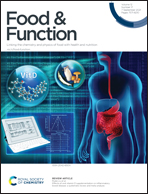Dietary squalene modifies plasma lipoproteins and hepatic cholesterol metabolism in rabbits†
Abstract
To evaluate the effects of squalene, the main unsaponifiable component of virgin olive oil, on lipid metabolism, two groups of male New Zealand rabbits were fed a 1% sunflower oil-enriched regular diet or the same diet containing 0.5% squalene for 4 weeks. Plasma triglycerides, total- and HDL-cholesterol and their lipoproteins were assayed. Analyses of hepatic lipid droplets, triglycerides, total- and non-esterified cholesterol, squalene, protein and gene expression, and cholesterol precursors were carried out. In the jejunum, the squalene content and mRNA and protein APOB expressions were measured. Finally, we studied the effect of cholesterol precursors in AML12 cells. Squalene administration significantly increased plasma total cholesterol, mainly carried as non-esterified cholesterol in IDL and large LDL, and corresponded to an increased number of APOB100-containing particles without accumulation of triglycerides and decreased reactive oxygen species. Despite no significant changes in the APOB content in the jejunum, the latter displayed increased APOB mRNA and squalene levels. Increases in the amounts of non-esterified cholesterol, squalene, lanosterol, dihydrolanosterol, lathosterol, cholestanol, zymostenol, desmosterol and caspase 1 were also observed in the liver. Incubation of AML12 cells in the presence of lanosterol increased caspase 1. In conclusion, squalene administration in rabbits increases the number of modified APOB-containing lipoproteins, and hepatic cholesterol biosynthesis is linked to caspase 1 probably through lanosterol.



 Please wait while we load your content...
Please wait while we load your content...